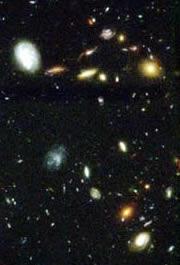 The Universe: getting ever bigger, ever faster.NASA
The Universe: getting ever bigger, ever faster.NASAIt has to be the closest ever shave. Two physicists have proposed that, a fraction of a second before a cataclysm that would destroy space-time itself, the Universe may escape by abruptly collapsing to a virtually empty state that 'resets' it for a fresh cycle of cosmic expansion.
The theory claims to reconcile the notion of a cyclic universe, which expands and contracts for eternity, with the second law of thermodynamics, which seems to imply that the current expansion cannot reverse.
As escape clauses go, this one is jaw-droppingly extravagant. Not only does the turnaround happen less than a thousand-trillion-trillionth (10-27) of a second before a 'Big Rip' in which everything falls apart, but it splits our Universe into countless new and independent ones.
And as the Universe has already gone through an infinite number of cycles, the model predicts an already infinite number of parallel universes, Lauris Baum and Paul Frampton of the University of North Carolina at Chapel Hill report in Physical Review Letters1.
What goes around
Why go to such extremes, rather than just assume that our Universe was produced in a one-off Big Bang that will make it expand for ever? Because, says Frampton, if you work backwards to the Big Bang using standard physics, the equations eventually stop making sense. "The model doesn't work," he says.
In a cyclic universe, says Frampton, physics need not break down.
But a 'bouncing' universe seems to conflict with one of the most fundamental physical principles, the second law of thermodynamics. This states that the entropy of the Universe — a kind of measure of its disorder — must increase. How can you reverse cosmic expansion without reversing this?
Another problem is that most cyclic models show the cycles getting shorter and shorter the further back you go, until you end up with the Big Bang that you set out to avoid.
Baum and Frampton's model universe is powered by 'phantom energy' — a hypothetical form of the dark energy that is speeding up the Universe's expansion.
As the Universe expands, phantom energy increasingly dominates the attractive forces of nature, such as gravity and electromagnetism. Galaxies will drift apart, then stars and planets will disintegrate, then atoms and subatomic particles. Finally, space itself is rent in a Big Rip (see 'Universe can surf the Big Rip'). At this point, says Frampton, "time will stop".
But Baum and Frampton say that a cyclic phantom-energy universe is rescued in the nick of time — without violating the second law.
In their model, the Universe expands to the brink of the Big Rip, when all atoms have disintegrated. At this stage, Frampton says, each atom will have expanded to about the size of the present visible Universe.
So even though the whole Universe has plenty of entropy, a chunk of this empty space has virtually zero entropy: expansion has diluted it almost infinitely.
At this point, the Universe will be a mosaic of causally unconnected patches — expansion will outpace the speed of light, preventing signals travelling between the patches.
In Baum and Frampton's model, 10-27 seconds or less before the Big Rip, everything contracts. The researchers essentially put such a contraction into their model 'by hand', although Frampton says that there are various theoretical reasons why it might occur.
The contraction generates lots of little separate universes from the mosaic of isolated patches. Each has plenty of energy, both dark and ordinary, but no matter and no entropy.
This sudden deflation is followed by rapid inflation, as is thought to have happened in the first instants of the Big Bang, vastly increasing each new universe's size in a fraction of a second.
So if the idea is right, we and everything we can see came from a patch of space lodged somewhere between two subatomic particles in a previous universe — and so on ad infinitum.
ADVERTISEMENT
Baum and Frampton's is not the only cyclic universe in town. Last year Paul Steinhardt of Princeton University, New Jersey, and Neil Turok at the University of Cambridge, UK, showed that a cyclic model could explain why our Universe seems so 'fine-tuned' to make stars and galaxies - and therefore us2 (see 'Cyclic universe could explain cosmic balancing act').
In Steinhardt and Turok's cyclic universe, dark energy is something other than the destructive phantom energy. Frampton hopes that measurements of the cosmic microwave background radiation — the afterglow of the early Universe — made by the Planck satellite, due to be launched in 2008 by the European Space Agency, will reveal the identity of dark energy.
Visit our bouncesbackfromthe.html">newsblog to read and post comments about this story.
